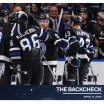Certainly, a Game Seven loss last week to the Washington Capitals wasn't how the Lightning wanted the season to end. But that tough defeat doesn't negate what was an incredible season. The Lightning set franchise records with 54 regular season victories, 25 regular season road wins, 113 regular season points and 53 regular season road points. They led the league in goals. They won their third-ever regular season division title. They advanced to their third Eastern Conference Final in the last four years and came within one victory of getting to the Stanley Cup Final. Here's a look back at how it all unfolded.
Mishkin's Musings: A look back at a remarkable season
Lightning broadcaster Dave Mishkin recaps the Lightning's record-setting 2017-18 campaign

© Mike Carlson
The First Half:The Lightning recorded the best first half in franchise history. Through their first 43 games (two contests past the official halfway point), the Lightning posted a record of 31-9-3. However, they didn't come out of the gates particularly well. It's true that they split a home-and-home set with Florida in their first two games, but they endured struggles in both. In the home opener, despite a 5-3 win, the Lightning were outshot 36-25. That shot disparity grew in the next game at Florida, a 5-4 loss in which they allowed 48 shots and were decisively outplayed. Two nights later, they spotted the visiting Capitals a 2-0 first period lead. But as the game progressed, the Lightning found their rhythm. They eventually rallied from a 3-1 deficit and tied the game on a Nikita Kucherov highlight-reel goal with under 10 minutes left in the third period. The Lightning dominated that final period, outshooting the Caps, 17-6. Brayden Point's power play goal in overtime secured the comeback victory. This was the triumph that triggered the Lightning's amazing first-half run.
Beginning with the win over Washington, the Lightning went 14-1-2 over a 17-game span. On most nights, they overwhelmed the opposition with their speed and relentless attack. Four of their most dominant performances of the regular season came during this stretch. On October 30, the Lightning beat the Panthers, 8-5, in Sunrise. The score makes the game seem closer than it actually was - unlike the earlier meetings between the clubs, the Lightning attacked the Panthers in waves and owned most of the puck possession. Final shots were 38-23 in favor of Tampa Bay.
The other three games followed a similar script, except that they came in a row and all took place on the West Coast. In beating the Sharks, Kings and Ducks, the Lightning put on a clinic featuring speed, skill, determination and tenacity. Their opponents simply couldn't keep up.
Maintaining that torrid pace wasn't going to be easy and sure enough, the Lightning dealt with a mini-slump at the end of November. Returning from California, the Lightning went 2-1-0 over the next three games, but then won just once during a four-game road trip.
That dip turned out to be an isolated one during this amazing first half. Beginning December with a home game against San Jose, the Lightning reeled off seven wins in a row. Starting with that home win over the Sharks, the Lightning went 10-1-0 over 11 games and 11-2-0 over 13 contests. They finished December with a 2-0 shutout win in Columbus on New Year's Eve and began 2018 with a similar 2-0 victory in Toronto on January 2. At that point, the Lightning were 29-8-2 through 39 games.
How did they do it? The Lightning's dominant first half was punctuated by an explosive offense. But one of the big keys to their offensive success was how well they defended. Team defense isn't just about playing without the puck - though the Lightning did that well in the first half, both in terms of rush coverage and d-zone coverage. Team D is also about puck management. One reason why the Lightning were able to overwhelm teams with their speed was that once they had the puck, they didn't turn it over. In the vast majority of their first 39 games, the Lightning owned most of the puck possession. So they were ones applying pressure, not the opposition.
The Second Half:That script shifted a bit in the second half. To be clear, this isn't an indictment of the Lightning's play in the second half. Following the January 2 win in Toronto, they won 25 of their final 43 games. As I mentioned when referencing the team's late-November dip, it would have been difficult for them to maintain the torrid pace they set through the first three months. But there were tangible differences between the team's play in first and second half. Two of the biggest revolved around puck management and penalty killing.
While the Lightning earned a point during a shootout loss in Montreal on January 4 and posted 45 shots on net, they did not play a strong, defensive game. Andrei Vasilevskiy (37 saves) and Carey Price (44 saves) put on an amazing goaltending display, allowing just one goal each. That defensive leakiness carried over into their next game, a 6-3 loss in Ottawa. A 5-2 win at Detroit and a 5-4 victory versus Carolina followed, but then the Lightning lost three games in a row for the only time all season. They yielded at least four goals in each of those games. So beginning with the Ottawa game, the Lightning allowed at least four goals in five of six contests.
As we know, the Lightning recovered from that three-game slide. To be precise, they went 23-11-2 in their final 36 games after the three-game skid. But some of the issues that plagued them during that early January stretch didn't completely go away. Problems with turnovers at points in games resulted in less puck possession. Their team goals against average crept up. And they allowed more shots per game than earlier in the year.
So intermittent puck management issues played a role. As did penalty killing. It was a strange year for the Lightning's PK. During the first two months of the season, the Lightning did well killing penalties. Heading into their December 17 game in Colorado, the Lightning owned a PK percentage of 82.3%. At the time, that was good for 12th place. As a point of reference, though, if they had maintained that average throughout the season, the Lightning would have finished with the sixth-best penalty kill in the league.
That game in Colorado was the turning point of the regular season for the PK. Although they built leads of 4-0 and 5-1, the Lightning had to hang on for a 6-5 victory. During Colorado's furious third period push, the Avs scored two power play goals. In the next game, the Lightning allowed four power play goals in a 4-3 loss to Vegas. Let's put these numbers in perspective. In their first 31 games plus two periods in Colorado, the Lightning allowed a total of 17 power play goals. Then they yielded six in four periods. After that, the PK didn't completely get back on track - until the first round playoff series against New Jersey.
It's not easy to assess the second-half Lightning because of the inevitable comparisons to the first-half Lightning. But let's give the second-half Lightning their due. As mentioned earlier, their record was excellent. They rallied in the final week to win the division. And they had some statement wins, too. Most notable were a January comeback overtime victory in Nashville and the 4-0 blanking of Boston in the regular season's final week. Without that latter triumph, the division title would have been out of reach.
The Playoffs: If there was any concern about whether the Lightning would tighten up their defensive game when the playoffs began, their performance in the opening round series win over New Jersey put those concerns to rest. Throughout the five-game series, the Lightning defended tightly and managed the puck efficiently. They received balanced scoring. There were only limited, isolated moments when the Devils carried play five-on-five. Even in Game Three, their only loss in the series, the Lightning played a strong, overall game.
In addition to their excellent five-on-five play, the Lightning did well on the penalty kill. They allowed only three power play goals during the entire series and two of those were five-on-three tallies.
It was much the same in the second round series against nemesis Boston. It's true that Boston's power play was more effective than New Jersey's had been, but the Lightning similarly dominated five-on-five play. Matched against the Patrice Bergeron line, Brayden Point, Tyler Johnson and Ondrej Palat recovered from a tough Game One and controlled that matchup for the rest of the series. It was an outstanding series win against an excellent opponent.
Unfortunately, the Lightning weren't able to get past Washington in the Conference Finals. Not only did the Caps play a structured, clean, efficient series, the Lightning didn't execute as well as they had in their two earlier series. As a result, the Caps did to the Lightning in five-on-five play what the Lightning had done to the Devils and Bruins. In many of the games, the Lightning found themselves back on their heels for extended periods of time. And the Lightning had difficulty doing the same to Washington. There were two notable exceptions. In the first period of Game Five, the Lightning dominated play and had the Caps completely out of sync. That strong start propelled them to victory. The other was, interestingly, Game Seven. It may not seem that way because the Lightning lost, 4-0. But through the first two periods of Game Seven, the Lightning decisively carried five-on-five play. They were unable to cash in on their numerous chances, though. At the other end, Washington didn't get many looks (at least during the first 40 minutes), but the Caps converted on three of them.
It is frustrating to know that the Lightning played so well in the first two rounds, but couldn't maintain it against the Caps. Certainly, Washington had something to do with that. But it's also a reminder of how difficult the Stanley Cup Playoff journey can be. A club needs to be playing its absolute best - or close to it - for two months and through four grueling rounds. Of the 16 teams that qualify for the playoffs, only one gets to finish its season with a win.
Having written all of that, hope springs eternal. 2017-18 may not have been the Lightning's year to win the Stanley Cup. But given the young core of this team - and the organization's track record of drafting and developing tremendous prospects (a number of whom excelled in AHL Syracuse this year) - the Lightning's "window" remains wide open for 2018-19 and beyond.


















